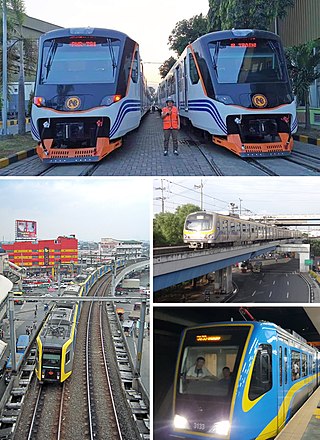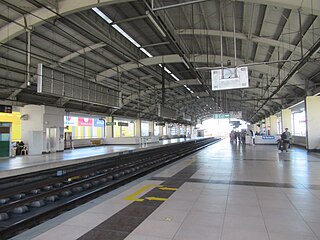
Pasig, officially the City of Pasig, is a highly urbanized city in the National Capital Region of the Philippines. According to the 2020 census, it has a population of 803,159 people.

Epifanio de los Santos Avenue, commonly referred to by its acronym EDSA, is a limited-access circumferential highway around Manila, the capital city of the Philippines. It passes through 6 of Metro Manila's 17 local government units or cities, namely, from north to south, Caloocan, Quezon City, San Juan, Mandaluyong, Makati, and Pasay.

Cainta, officially the Municipality of Cainta, is a 1st class urban municipality in the province of Rizal, Philippines. According to the 2020 census, it has a population of 376,933 people.

The Metro Rail Transit Line 3, also known as the MRT Line 3, MRT-3 or Metrostar Express, is a light rapid transit system line of Metro Manila, the Philippines.

Rail transportation in the Philippines is currently used mostly to transport passengers within Metro Manila and provinces of Laguna and Quezon, as well as a commuter service in the Bicol Region. Freight transport services once operated in the country, but these services were halted. However, there are plans to restore old freight services and build new lines. From a peak of 1,100 kilometers (680 mi), the country currently has a railway footprint of 533.14 kilometers (331.28 mi), of which only 129.85 kilometers (80.69 mi) are operational as of 2024, including all the urban rail lines. World War II, natural calamities, underspending, and neglect have all contributed to the decline of the Philippine railway network. In the 2019 Global Competitiveness Report, the Philippines has the lowest efficiency score among other Asian countries in terms of efficiency of train services, receiving a score of 2.4, and ranking 86th out of 101 countries globally. The government is currently expanding the railway network up to 1,900 kilometers (1,200 mi) by 2022 through numerous projects.

EDSA station is an elevated Light Rail Transit (LRT) station located on the LRT Line 1 (LRT-1) system in Pasay. The station is situated on the intersection of Taft Avenue and Epifanio de los Santos Avenue, better known as EDSA, one of Metro Manila's major thoroughfares. The station was named after EDSA, which in turn is named after Epifanio de los Santos, a noted historian.

Araneta Center–Cubao station is an elevated Light Rail Transit (LRT) station located on the LRT Line 2 (LRT-2) system in Cubao, Quezon City. It is named after the old name of Araneta City, a mixed-use development.

Ortigas station is an elevated Metro Rail Transit (MRT) station located on the MRT Line 3 (MRT-3) system in the Mandaluyong portion of Ortigas Center. The station is named after either Ortigas Center or Ortigas Avenue, which is nearby.

Fernando Poe Jr. station is the current northern terminus of the Light Rail Transit Line 1 (LRT-1) system. It opened on October 22, 2010, as part of the LRT-1 North Extension Project, as Roosevelt and was renamed to its current name on August 20, 2023, almost two years after the namesake avenue was officially renamed after the Filipino actor.

The North Triangle Common Station, popularly known as the Common Station, is an under-construction rapid transit terminal and transport hub that will connect LRT Line 1, MRT Line 3, and MRT Line 7, and the nearby Metro Manila Subway. It is located in Bagong Pag-asa, Quezon City, Philippines, and is named after its location, which is at the corner of EDSA and North Avenue.

Robinsons Galleria, is a mixed-use complex and shopping mall located at EDSA corner Ortigas Avenue in Quezon City, Metro Manila, the Philippines. The mall is owned by Robinsons Malls, and it is their flagship mall. It is the first Robinsons Mall to bear the Galleria branding and was built on January 12, 1990, with a total gross floor area of approximately 216,000 m2 (2,330,000 sq ft).

Ortigas Avenue is a 12.1 km (7.5 mi) highway running from eastern Metro Manila to western Rizal in the Philippines. It is one of the busiest highways in Metro Manila, serving as the main thoroughfare of the metro's east–west corridor, catering mainly to the traffic to and from Rizal.

Shaw Boulevard is a 4-8 lane highway connecting the cities of Mandaluyong and Pasig in the Philippines. The boulevard is named after William James Shaw, the founder of the Wack Wack Golf and Country Club in Mandaluyong. The road is one of the major thoroughfares of the Ortigas Center in Mandaluyong and Pasig, housing many shopping malls like the Starmall shopping center and the posh Shangri-La Plaza at the EDSA-Shaw intersection and The Marketplace, which is visible from the Kalentong-Shaw intersection and Sevilla Bridge.

The Manila East Road, also known as National Road and National Highway, is a two-to-four lane primary and secondary highway connecting Metro Manila to the provinces of Rizal and Laguna in the Philippines.

Radial Road 5, more commonly referred to as R-5, is a network of roads and bridges that all together form the fifth radial road of Manila in the Philippines. The road links the City of Manila with Mandaluyong and Pasig in the east, leading out of Metro Manila into the province of Rizal and south towards Laguna. It is the only arterial road traversing the east side of Laguna de Bay.

The following is an alphabetical list of articles related to the Philippine capital region of Metro Manila.
The Metro Manila Subway, formerly known as the Mega Manila Subway (MMS), is an under-construction underground rapid transit line in Metro Manila, Philippines. The 33-kilometer (21 mi) line, which will run north–south between Valenzuela, Quezon City, Pasig, Taguig, Parañaque and Pasay, consists of 17 stations between the East Valenzuela and Bicutan stations. It will become the country's second direct airport rail link after the North–South Commuter Railway, with a branch line to Ninoy Aquino International Airport.

The Metro Rail Transit Line 7, also known as MRT Line 7 or MRT-7, is a rapid transit line under construction in the Philippines. When completed, the line will be 22.8 kilometers long, with 14 stations, and the first line to have a third rail electrification. The line runs in a northeast–southwest direction, beginning at San Jose del Monte, Bulacan up to the North Triangle Common Station in North Avenue, Quezon City.
The Metro Rail Transit Line 8, or MRT-8, also known as PNR East-West Line, is a proposed rapid transit line in the Philippines. It would be a 9-kilometer (5.6 mi) railway system connecting Sampaloc, Manila and Diliman, Quezon City via Commonwealth Avenue, Quezon Avenue, and España Boulevard.

National Route 59 (N59) is a primary national route that forms part of the Philippine highway network, running from Antipolo, Rizal to Cubao, Quezon City, Metro Manila.


















